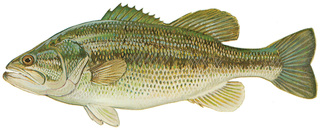
West Virginia waters harbor a diverse assemblage of fishes. There are some 160 native species in our lakes, streams, and rivers, but due to many accidental or intentional introductions, the total number present actually stands at 178. These species are distributed among 24 different families, with about 75 percent found in just five families. These five families are the carps and minnows (60 species), perches (31), suckers (18), basses and sunfishes (14), and catfishes (12).
The mountains that bisect the state have played a critical role in the kinds of fishes found here. Our western flowing waters (including the Monongahela, Little Kanawha, Kanawha, Guyandotte, and Big Sandy rivers and their tributaries) drain to the Ohio River, while our Atlantic slope streams (the Potomac River and its tributaries and some tributaries of the James) flow eastward to the Chesapeake Bay. Although many of the same species can be found on both sides of the mountains, there are approximately 130 native species known from the Ohio River waters, but less than 50 from the Atlantic slope drainages. This lopsided difference is partially explained by the fact that the majority of fishes in North America originated during millions of years from river valleys found in the present central United States.
Of particular interest are the special fishes found in the New River of the upper Kanawha River drainage. The New, a remnant of the ancient Teays River system, is generally considered by geologists to be the second-oldest river in the world and the oldest in North America. Biological evidence supports the uniqueness of this drainage, which starts in North Carolina and continues on through the Virginias. Extremely special to these waters are seven fishes that are found nowhere else in the world. These are the New River shiner, bigmouth chub, Kanawha minnow, Bluestone sculpin, candy darter, Appalachian darter, and the Kanawha darter. It is thought that the barrier created by Kanawha Falls and the harsh environment of the New and Gauley river gorges contributed to the isolation and evolution of these endemic fishes, and to the fact that there are far fewer species above the falls than below.
Species typical to our large rivers are walleye, sauger, freshwater drum, bluegill, longear sunfish, smallmouth bass, largemouth bass, flathead and channel catfish, black and white crappie, gizzard shad, skipjack herring, mooneye, longnose gar, redhorse suckers (five species), buffalo suckers (three species), carpsuckers (three species), emerald shiners, channel shiner, logperch, banded darter, blackside darter, and variegate darter. Small-stream fishes include trout, mottled sculpin, blacknose dace, longnose dace, creek chubs, rosyface shiner, striped shiner, stoneroller minnow, fantail darter, greenside darter, johnny darter, white sucker, hog sucker, and mottled sculpin.
Lakes are artificial environments in West Virginia. (Trout Pond, a two-acre lake in the Eastern Panhandle, is exceptional as our only natural lake.) Species in our large man-made lakes include smallmouth and largemouth bass, walleye, channel catfish, black and white crappie, bluegill, and emerald shiners.
The most common fishes in the state are smallmouth and largemouth bass, bluegill, green sunfish, rock bass, channel catfish, northern hogsuckers, white suckers, striped shiner, silver shiner, mimic shiner, rosyface shiner, spotfin shiner, silverjaw minnow, golden redhorse, white sucker, hog sucker, fantail darter, and greenside darter.
West Virginia fishes have some odd habits, often to do with reproduction. Our official state fish, the brook trout, is the only native trout and the only native fish that spawns in the fall; its eggs incubate all winter until spring. Most of our fish species mate in spring or early summer and hatch within a couple of weeks. Then there is the incomparable behavior of the American eel, which becomes sexually mature after several years, migrates from our eastern streams to the Atlantic Ocean, mates, and their hatched young float back to the mainland in ribbon-like larval stage, transform into a transparent ‘glass eel,’ and then change into the typical dark-bodied juvenile. The Moundbuilding fishes, such as chubs and fallfish, carry stones by mouth to construct these piles as their nests, while depression nesters, such as the stoneroller minnow, may actually roll debris away. Many fishes may undergo drastic transformations before they find their mates. Some grow ‘‘horns,’’ others including the darters get extremely colorful, and some have body parts that change shape and size.
Some fish have intriguing food habits. For example, the jawless lampreys are often parasitic on other fish. Our six-foot-long paddlefish eats only microscopic plants and animals. The stomachless minnows and suckers have teeth in their throats instead of their mouths, and suckers have a telescoping mouth designed for ‘‘sucking’’ food off the bottom.
Whatever their ways, West Virginia’s fishes are a rich resource, an endless source of fascination, and a vital part of our state’s fauna.
View a gallery of Sport Fish of West Virginia
This Article was written by Dan Cincotta
Last Revised on November 27, 2023
Sources
Page, L. M. & B. M. Burr. A Field Guide to Freshwater Fishes of North America North of Mexico. Boston: Houghton Mifflin, 1991.
Stauffer, Jay R. Jr., Jeffrey Boltz & Laura White. The Fishes of West Virginia. Philadelphia: Academy of Natural Sciences of Philadelphia, 1995.
Cite This Article
Cincotta, Dan "Fish." e-WV: The West Virginia Encyclopedia. 27 November 2023. Web. 26 July 2024.



Comments?
There aren't any comments for this article yet.
Click here to read and contribute to the discussion →